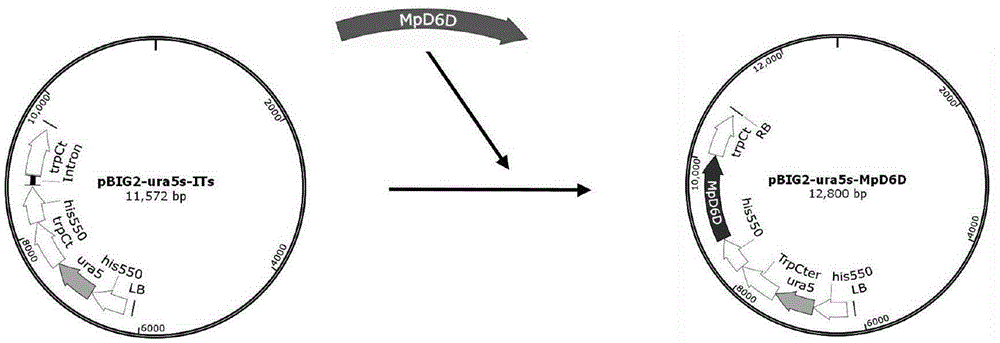Recombinant mortierella alpina strain for heterologous expression of MpFADS6 gene, construction method of recombinant mortierella alpina strain and application of recombinant mortierella alpina strain in production of EPA
A kind of Mortierella alpine, heterologous expression technology, applied in the field of bioengineering
- Summary
- Abstract
- Description
- Claims
- Application Information
AI Technical Summary
Problems solved by technology
Method used
Image
Examples
Embodiment 1
[0059] Example 1: Synthesis of FADS6 gene (MpFADS6) derived from Micromonas pumilus CCMP1545
[0060] According to the sequence information of the MpFADS6 gene derived from Micromonas pumilus CCMP1545 (GenBank number KU236373), primers P1 and P2 were designed, the underlines were the enzyme cutting sites EcoRI and SmaI respectively, and the plasmid PUC-MpFADS6 containing the MpFADS6 gene was used as a template (Shanghai Sunny Biotechnology Co., Ltd.), P1 / P2 as primers, using KOD high-fidelity polymerase to obtain the MpFADS6 fragment by PCR. The PCR program was: 94°C for 40s, 55°C for 40s, 68°C for 1.5min, 30 cycles, and the PCR amplified products were separated by 1.0% agarose gel electrophoresis and recovered.
[0061] P1 (sense): 5'-TACCG GAATTC ATGTGCCCGCCGAAGACGGACGGC-3'
[0062] P2 (antisense): 5'-TCTAG CCCGGG TCAGTGCGCCTTTCTCCGCCTTGCC-3'
Embodiment 2
[0063] Example 2: Construction of binary expression vector pBIG2-ura5s-MpFADS6
[0064] 1. Enzyme digestion reaction
[0065]At 37°C, the MpFADS6 fragment and the vector pBIG2-ura5s-ITs fragment were digested with restriction enzymes EcoRI and SmaI, the product was purified to recover the MpFADS6 fragment, and the pBIG2-ura5s fragment was recovered by gel cutting and purification. Enzyme digestion system (50μL): 1μL EcoRI (Cat. No. FD0275), 1 μL SmaI (Cat. No. FD0663), 40 μL plasmid or PCR product, 5 μL 10X Buffer (Fermentas Company), 3 μL of deionized water, incubated at 37°C for 2h.
[0066] 2. Ligation reaction
[0067] The digested MpFADS6 fragment MpFADS6 was ligated with the vector pBIG2-ura5s using T4 ligase, and incubated at 4°C for 12 hours to obtain the recombinant expression vector pBIG2-ura5s-MpFADS6. The ligation system is (10 μL): 5 μL of the digested fragment of the target gene, 3 μL of the digested fragment of the vector, 1 μL of 10X ligase buffer, 1 μL...
Embodiment 3
[0080] Example 3: Agrobacterium tumefaciens-mediated transformation of Mortierella alpina strain MAU1 (CCFM501, namely CGMCCNo.8414)
[0081] On the basis of the existing domestic and foreign literature reports on the transformation method of Agrobacterium tumefaciens, appropriate optimization was carried out, as follows:
[0082] 1) Agrobacterium tumefaciens C58C1 containing the pBIG2-ura5s-MpFADS6 plasmid stored at -80°C were streaked on YEP solid medium plates containing 100 μg / mL rifampicin and 100 μg / mL kanamycin. Incubate in the dark at 28°C for 48 hours.
[0083] 2) Pick a single clone and inoculate it into 15 mL of liquid YEP medium containing 100 μg / mL rifampicin and 100 μg / mL kanamycin at 28° C., 200 rpm, and incubate in the dark for 36 hours.
[0084] 3) Centrifuge at 8000g for 5 minutes to collect the bacterial cells, and discard the supernatant. Add 5mL IM medium to resuspend the bacteria, centrifuge at 8000g for 5 minutes, and discard the supernatant. Add 2mL ...
PUM
 Login to View More
Login to View More Abstract
Description
Claims
Application Information
 Login to View More
Login to View More - Generate Ideas
- Intellectual Property
- Life Sciences
- Materials
- Tech Scout
- Unparalleled Data Quality
- Higher Quality Content
- 60% Fewer Hallucinations
Browse by: Latest US Patents, China's latest patents, Technical Efficacy Thesaurus, Application Domain, Technology Topic, Popular Technical Reports.
© 2025 PatSnap. All rights reserved.Legal|Privacy policy|Modern Slavery Act Transparency Statement|Sitemap|About US| Contact US: help@patsnap.com



